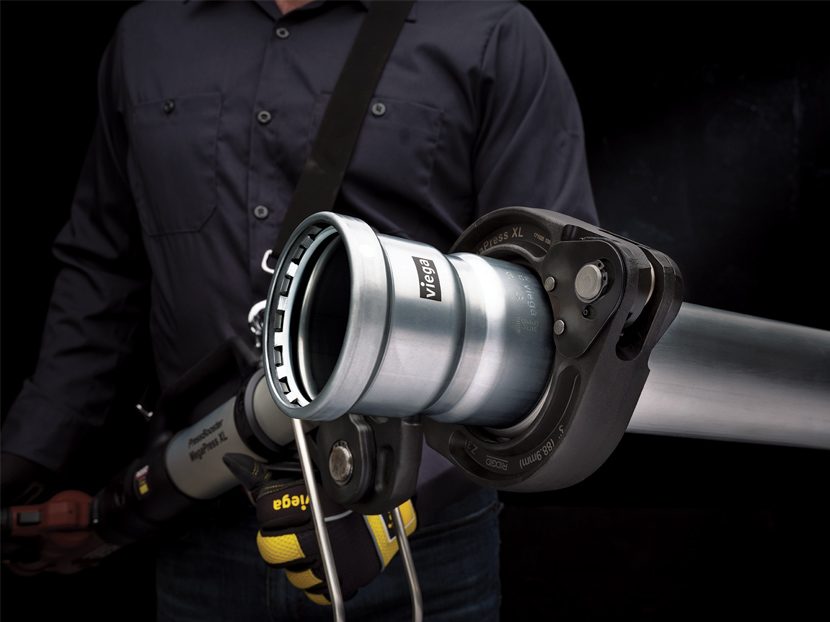The Advantages of Pressing Pipe
This pipe-joining technique is safe and reliable, and saves time and money.

At a time when skilled labor is at a premium and profit margins are tighter than ever, savvy contractors are looking for ways to save time and money without compromising quality.
Joining pipe has long been one of the most labor-intensive parts of many jobs. Welding, soldering, brazing and threading are time-consuming and require years of training and practice to do them at a professional level. These techniques, some of which require flame and heat and which produce fumes, also pose a workplace danger and can require additional equipment.
There is an alternative, which saves time and money while still producing expert results. It’s pressing; using a hydraulic tool to apply force to a fitting to join two pieces of pipe.
Though pressing is not yet the standard in the United States and Canada, it’s not new or unproven technology. Pressing can be used with copper, copper-nickel, stainless steel and carbon steel, as well as PEX. Its suitability to different materials means it can be used across a variety of residential, commercial and industrial applications, from gas and corrosive chemicals to steam and water.
It’s been the most popular method of joining pipe in Europe for decades and has made tremendous inroads in North America since its introduction here in 1999.
The most significant advantages of pressing are detailed here:
• Time. This is the benefit most readily apparent — and shocking — to contractors who try pressing for the first time after years of using traditional methods.
Pressing is fast. Many different fitting types can be pressed in under 10 seconds, a drastic time savings over other methods. On average, press technology provides a time savings of 50 percent to 90 percent. Multiply the time saved per fitting by hundreds or thousands of fittings on a large job and it can lop days off a project.
And there is no waiting time for curing and drying.
The rapidity of pressing is a huge advantage when making repairs. In addition to allowing the contractor to work and make connections more quickly, pressing saves time because it can be done on wet pipe systems, thus eliminating the need to shut down the system and dependent operations during the fix. In commercial and industrial applications, it can save the customer hundreds of thousands of dollars in lost downtime.
• Money. Every contractor knows time is money. The time savings that pressing offers allow contractors to bid more competitively, cut labor costs and take on more jobs — advantages which can make a huge difference in the bottom line.
For installed cost savings, pressing is approximately 30 percent less expensive when compared to welding and threading. In labor costs alone, pressing is 80 percent to 90 percent more cost-effective compared to welding, 30 percent to 50 percent more cost-effective when compared to threading and up to 60 percent more cost-effective compared to grooving.
The pressing tools themselves, which are made by several manufacturers, including RIDGID and Milwaukee, are less expensive than welding equipment.
• Safety. Pressing is flameless, which makes it safer than traditional systems and eliminates the need for flux, flammable gases or fumes. That makes the system easier and safer to set up than traditional pipe-joining methods. No flame means no fire watch, which saves money.
The pressing tools eliminate the need for expensive and heavy equipment such as welding tanks and threading machines, which can be difficult and time-consuming to transport. Users also don’t need the helmets and other safety gear required by welding.
Pressing is cleaner as well since it requires no welding rods or cutting oils. And, because a good job is a clean job, pressing leaves no joining material buildup, exposed threads or tarnish, creating a clean, professional look.
• Training. The shortage of workers in all the skilled trades — from welding to carpentry — has been well-documented. While several worthwhile initiatives are underway to address the problem, it’s a long way from being solved. It’s likely going to get worse.
This can force contractors to make accommodations on who they hire and how much experience they can demand from applicants. It also can require making expensive investments in training workers.
Pressing is easier to learn than welding, brazing and soldering, which means a newly trained worker is ready to go out on the job sooner. It can free up more experienced and highly skilled workers for jobs that require welding or other, more difficult techniques. It’s an enormous advantage for a contractor dealing with a shortage of skilled labor.
• Reliability. Nothing is worse than being called back to a job because of a leak that went undetected at the time of the work or developed later because of a poor joining. Not only is it expensive and embarrassing, it can also destroy your reputation with the client and lead to a bad word-of-mouth experience.
Pressing is more reliable than traditional techniques that leave more room for user error and inconsistencies.
Different brands of press-on plumbing fittings have different features but they all deliver more secure connections. The pressing tool is designed and calibrated to apply the exact amount of force needed to form a permanent, watertight joint. That means all press connections are consistent, no matter the experience or skill of the installer. And, unlike grooved and threaded connections, pressing doesn’t require installers to thin the pipe walls to make a secure connection.
This consistency, regardless of the skills of the operator, helps control variable labor costs on large jobs and allows for more accurate estimating.
Pressing has too many advantages over other methods of joining pipe not to give it a try.




